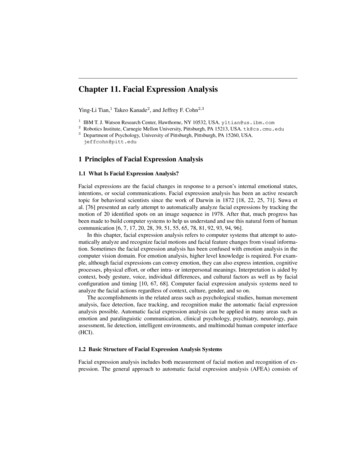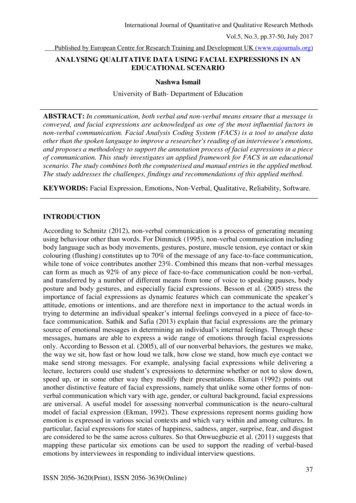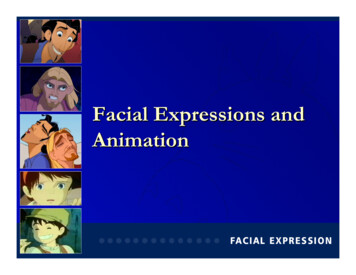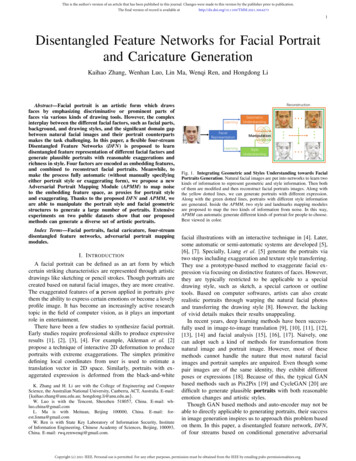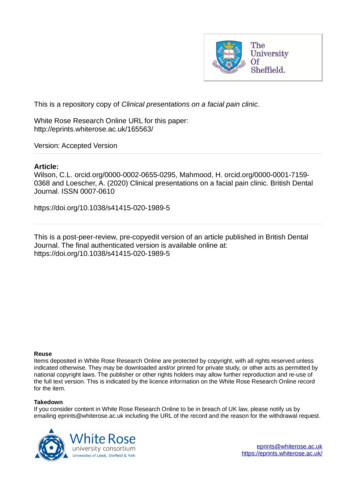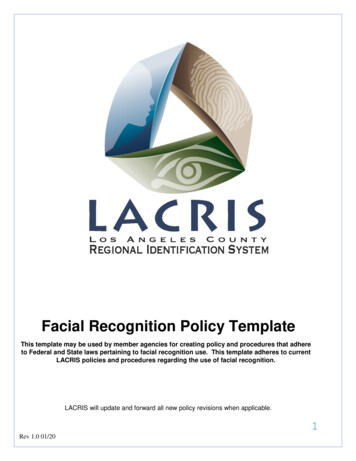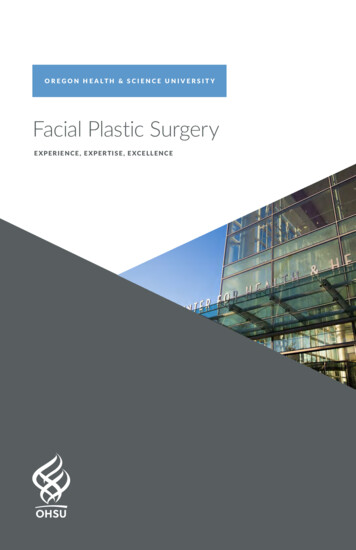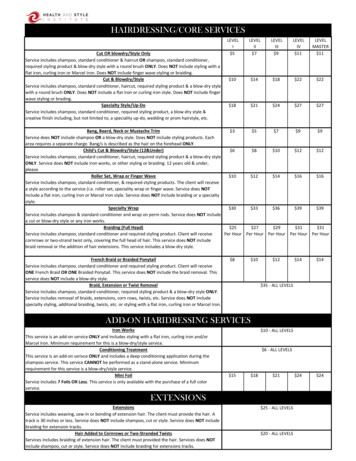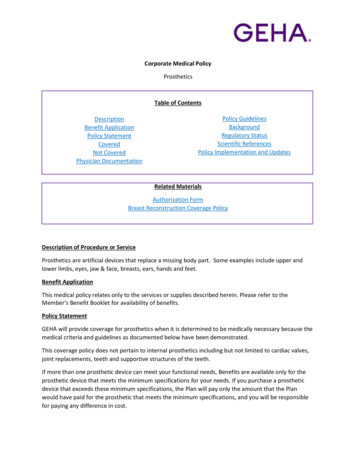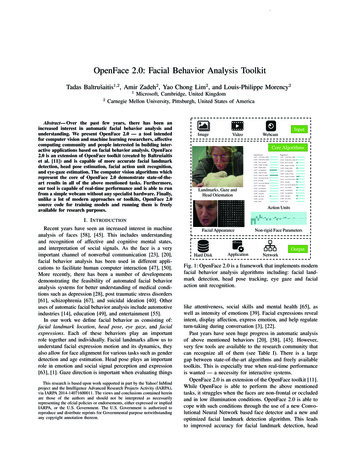
Transcription
2018 13th IEEE International Conference on Automatic Face & Gesture RecognitionOpenFace 2.0: Facial Behavior Analysis ToolkitTadas Baltrušaitis1,2 , Amir Zadeh2 , Yao Chong Lim2 , and Louis-Philippe Morency2Microsoft, Cambridge, United KingdomCarnegie Mellon University, Pittsburgh, United States of America12Abstract— Over the past few years, there has been anincreased interest in automatic facial behavior analysis andunderstanding. We present OpenFace 2.0 — a tool intendedfor computer vision and machine learning researchers, affectivecomputing community and people interested in building interactive applications based on facial behavior analysis. OpenFace2.0 is an extension of OpenFace toolkit (created by Baltrušaitiset al. [11]) and is capable of more accurate facial landmarkdetection, head pose estimation, facial action unit recognition,and eye-gaze estimation. The computer vision algorithms whichrepresent the core of OpenFace 2.0 demonstrate state-of-theart results in all of the above mentioned tasks. Furthermore,our tool is capable of real-time performance and is able to runfrom a simple webcam without any specialist hardware. Finally,unlike a lot of modern approaches or toolkits, OpenFace 2.0source code for training models and running them is freelyavailable for research purposes.InputImageVideoWebcamCore AlgorithmsLandmarks, Gaze andHead OrientationAction UnitsI. I NTRODUCTIONRecent years have seen an increased interest in machineanalysis of faces [58], [45]. This includes understandingand recognition of affective and cognitive mental states,and interpretation of social signals. As the face is a veryimportant channel of nonverbal communication [23], [20],facial behavior analysis has been used in different applications to facilitate human computer interaction [47], [50].More recently, there has been a number of developmentsdemonstrating the feasibility of automated facial behavioranalysis systems for better understanding of medical conditions such as depression [28], post traumatic stress disorders[61], schizophrenia [67], and suicidal ideation [40]. Otheruses of automatic facial behavior analysis include automotiveindustries [14], education [49], and entertainment [55].In our work we define facial behavior as consisting of:facial landmark location, head pose, eye gaze, and facialexpressions. Each of these behaviors play an importantrole together and individually. Facial landmarks allow us tounderstand facial expression motion and its dynamics, theyalso allow for face alignment for various tasks such as genderdetection and age estimation. Head pose plays an importantrole in emotion and social signal perception and expression[63], [1]. Gaze direction is important when evaluating thingsFacial AppearanceOutputHard DiskApplicationNetworkFig. 1: OpenFace 2.0 is a framework that implements modernfacial behavior analysis algorithms including: facial landmark detection, head pose tracking, eye gaze and facialaction unit recognition.like attentiveness, social skills and mental health [65], aswell as intensity of emotions [39]. Facial expressions revealintent, display affection, express emotion, and help regulateturn-taking during conversation [3], [22].Past years have seen huge progress in automatic analysisof above mentioned behaviors [20], [58], [45]. However,very few tools are available to the research community thatcan recognize all of them (see Table I). There is a largegap between state-of-the-art algorithms and freely availabletoolkits. This is especially true when real-time performanceis wanted — a necessity for interactive systems.OpenFace 2.0 is an extension of the OpenFace toolkit [11].While OpenFace is able to perform the above mentionedtasks, it struggles when the faces are non-frontal or occludedand in low illumination conditions. OpenFace 2.0 is able tocope with such conditions through the use of a new Convolutional Neural Network based face detector and a new andoptimized facial landmark detection algorithm. This leadsto improved accuracy for facial landmark detection, headThis research is based upon work supported in part by the Yahoo! InMindproject and the Intelligence Advanced Research Projects Activity (IARPA),via IARPA 2014-14071600011. The views and conclusions contained hereinare those of the authors and should not be interpreted as necessarilyrepresenting the ofcial policies or endorsements, either expressed or impliedIARPA, or the U.S. Government. The U.S. Government is authorized toreproduce and distribute reprints for Governmental purpose notwithstandingany copyright annotation thereon.978-1-5386-2335-0/18/ 31.00 2018 IEEEDOI 10.1109/FG.2018.00019Non-rigid Face Parameters59
ToolCOFW[13]FaceTrackerdlib [37]ChehraMenpo [2]CFAN [77][73]TCDCNWebGazer.jsEyeTabOKAOAffdexTree DPM [85]OpenPose [15]CFSS [83]iCCR [56]LEARTAUDOpenFaceOpenFace 2.0ApproachRCPR[13]CLM[57][35][5]AAM, CLM, SDM1[77]Reg. For [73]CNN [81][54][71]unknownunknown[85]Part affinity Fields [15]CFSS [83]iCCR [56]LEAR [46]TAUD [33][8], [7][70], [75], [78]Landmark!!!!!!!!Head BLE I: Comparison of facial behavior analysis tools. Free indicates that the tool is freely available for research purposes,Train the availability for model training source code, Test the availability of model fitting/testing/runtime source code, Binarythe availability of model fitting/testing/runtime executable. Note that most tools only provide binary versions (executables)rather than the source code for model training and fitting. Notes: (1 ) The implementation differs from the originally proposedone based on the used features, (2 ) the algorithms implemented are capable of real-time performance but the tool does notprovide it, (3 ) requires GPU support.consideration when the project is no longer actively supported. Further, lack of training code makes the reproductionof experiments on different datasets very difficult. Finally, anumber of tools expect face detections (in form of boundingboxes) to be provided by an external tool, in contrastOpenFace 2.0 comes packaged with a modern face detectionalgorithm [78].Head pose estimation has not received the same amountof interest as facial landmark detection. An early example ofa dedicated head pose estimation toolkit is the Watson system[52]. There also exists a random forest based frameworkthat allows for head pose estimation using depth data [24].While some facial landmark detectors include head poseestimation capabilities [4], [5], most ignore this importantbehavioral cue. A more recent toolkit for head (and the restof the body) pose estimation is OpenPose [15], however, itis computationally demanding and requires GPU accelerationto achieve real-time performance.Facial expression is often represented using facial action units (AUs), which objectively describe facial muscleactivations [21]. There are very few freely available toolsfor action unit recognition (see Table I). However, there area number of commercial systems that among other functionality perform action unit recognition, such as: Affdex2 ,Noldus FaceReader 3 , and OKAO4 . Such systems face anumber of drawbacks: sometimes prohibitive cost, unknownalgorithms, often unknown training data, and no publicbenchmarks. Furthermore, some tools are inconvenient to usepose tracking, AU recognition and eye gaze estimation. Maincontributions of OpenFace 2.0 are: 1) new and improvedfacial landmark detection system; 2) distribution of readyto use trained models; 3) real-time performance, withoutthe need of a GPU; 4) cross-platform support (Windows,OSX, Ubuntu); 5) code available in C (runtime), Matlab(runtime and model training), and Python (model training).Our work is intended to bridge that gap between existingstate-of-the-art research and easy to use out-of-the-box solutions for facial behavior analysis. We believe our tool willstimulate the community by lowering the bar of entry intothe field and enabling new and interesting applications1 .II. P REVIOUS WORKA full review of prior work in facial landmark detection,head pose, eye gaze, and action unit recognition is outside thescope of this paper, we refer the reader to recent reviews inthese respective fields [18], [31], [58], [17]. As our contribution is a toolkit, we provide an overview of available tools foraccomplishing the individual facial behavior analysis tasks.For a summary of available tools see Table I.Facial landmark detection – there exists a number offreely available tools that perform facial landmark detectionin images or videos, in part thanks to availability of recentgood quality datasets and challenges [60], [76]. However,very few of them provide the source code and instead onlyprovide runtime binaries, or thin wrappers around libraryfiles. Binaries only allow for certain predefined functionality(e.g. only visualizing the results), are very rarely crossplatform, and do not allow for bug fixes — an important2 http://www.affectiva.com/solutions/affdex/3 ucts/facereader4 https://www.omron.com/ecb/products/mobile/1 https://github.com/TadasBaltrusaitis/OpenFace60
DimensionalityReductionInputFace Detection3D Facial LandmarkDetectionEye GazeEstimationHead Pose Appearance ExtractionEstimationFace AlignmentFeature FusionPerson NormalizationAction UnitRecognitionFig. 2: OpenFace 2.0 facial behavior analysis pipeline, including: landmark detection, head pose and eye gaze estimation,facial action unit recognition. The outputs from all of these systems (indicated in green) can be saved to disk or sent vianetwork in real-time.more details about the algorithm refer to Zadeh et al. [75],example landmark detections can be seen in Figure 3.1) OpenFace 2.0 novelties: Our C implementation ofCE-CLM in OpenFace 2.0 includes a number of speed optimizations that enable real-time performance. These includedeep model simplification, smart multiple hypotheses, andsparse response map computation.Deep model simplification The original implementationof CE-CLM used deep networks for patch experts with 180, 000 parameters each (for 68 landmarks at 4 scalesand 7 views). We retrained the patch experts for first twoscales using simpler models by narrowing the deep networkto half the width, leading to 90, 000 parameters each. Wechose the final model size after exploring a large range ofalternatives, and chose the smallest model that still retainscompetitive accuracy. This reduces the model size and improves the speed by 1.5 times, with minimal loss in accuracy.Furthermore, we only store half of the patch experts, byrelying on mirrored views for response computation (e.g. westore only the left eye recognizesr, instead of both eyes). Thisreduces the model size by a half. Both of these improvementsreduced the model size from 1, 200MB to 400MB.Smart multiple hypotheses In case of landmark detectionin difficult in-the-wild and profile images CE-CLM usesmultiple initialization hypotheses (11 in total) at differentorientations. During fitting it selects the model with thebest converged likelihood. However, this slows down theapproach. In order to speed this up we perform an earlyhypothesis termination, based on current model likelihood.We start by evaluating the first scale (out of four differentscales) for each initialization hypothesis sequentially. If thecurrent likelihood is above a threshold τi (good enough), wedo not evaluate further hypotheses. If none of the hypothesesare above τi , we pick three hypotheses with the highestlikelihood for evaluation in further scales and pick the bestresulting one. We determine the τi values that lead to smallfitting errors on for each view on training data. This leadsto a 4 time performance improvement of landmark detectionin images and for initializing tracking in videos.Sparse response maps An important part of CE-CLM isthe computation of response maps for each facial landmark.Typically it is calculated in a dense grid around the currentlandmark estimate (e.g. 15 15 pixel grid). However, insteadof computing the response map for a dense grid we can doit in a sparse grid by skipping every other pixel, followed byby being restricted to a single machine (due to MAC addresslocking or requiring of USB dongles). Finally, and mostimportantly, the commercial product may be discontinuedleading to impossible to reproduce results due to lack ofproduct transparency (this is illustrated by discontinuationof FACET, FaceShift, and IntraFace).Gaze estimation – there are a number of tools andcommercial systems for gaze estimation, however, majorityof them require specialized hardware such as infrared orhead mounted cameras [19], [42], [62]. There also exist acouple of commercial systems available for webcam basedgaze estimation, such as xLabs5 and EyesDecide6 , but theysuffer from previously mentioned issues that commercialfacial expression analysis systems do. There exist severalrecent free webcam eye gaze tracking projects [27], [71],[54], [68], but they struggle in real-world scenarios and oftenrequire cumbersome manual calibration steps.In contrast to other available tools (both free and commercial) OpenFace 2.0 provides both training and testing codeallowing for modification, reproducibility, and transparency.Furthermore, our system shows competitive results on realworld data and does not require any specialized hardware.Finally, our system runs in real-time with all of the facialbehavior analysis modules working together.III. O PEN FACE 2.0 PIPELINEIn this section we outline the core technologies used byOpenFace 2.0 for facial behavior analysis (see Figure 2 fora summary). First, we provide an explanation of how wedetect and track facial landmarks, together with novel speedenhancements that allow for real-time performance. We thenprovide an outline of how these features are used for headpose estimation and eye gaze tracking. Finally, we describeour facial action unit intensity and presence detection system.A. Facial landmark detection and trackingOpenFace 2.0 uses the recently proposed ConvolutionalExperts Constrained Local Model (CE-CLM) [75] for faciallandmark detection and tracking. The two main componentsof CE-CLM are: Point Distribution Model (PDM) whichcaptures landmark shape variations and patch experts whichmodel local appearance variations of each landmark. For5 https://xlabsgaze.com/6 https://www.eyesdecide.com/61
Fig. 5: Sample eye registrations on 300-W dataset.based on currently detected landmarks. If our CNN validationmodule reports that tracking failed we reinitialize the modelusing the MTCNN face detector.To optimize matrix multiplications required for patchexpert computation and face detection we used the OpenBLAS7 . It allows for specific CPU architecture optimizedcomputation. This allows us to use Convolutional NeuralNetwork (CNN) based patch expert computation and facedetection without sacrificing real-time performance on devices without dedicated GPUs. This led to a 2-5 times(based on CPU architecture) performance improvement whencompared to OpenCV matrix multiplication.All of the above mentioned performance improvementsand a C implementation, allows CE-CLM landmark detection to achieve 30-40Hz frame rates on a quad core3.5GHz Intel i7-2700K processor, and 20Hz frame rates on aSurface Pro 3 laptop with a 1.7GHz dual core Intel core i74650U processor, without any GPU support when processing640 480 px videos. This is 30 times faster than the originalMatlab implementation of CE-CLM [75].Fig. 3: Example landmark detection from OpenFace 2.0, notethe ability to deal with profile faces and occlusion.Fig. 4: Sample gaze estimations on video sequences; greenlines represent the estimated eye gaze vectors, the blue boxesa 3D bounding box around the head.a bilinear interpolation to map it back to a dense grid. Thisleads to 1.5 times improvement in model speed on imagesand videos with minimal loss of accuracy.2) Implementation details: The PDM used in OpenFace2.0 was trained on two datasets — LFPW [12] and Helen[41] training sets. This resulted in a model with 34 nonrigid and 6 rigid shape parameters. For training the CE-CLMpatch experts we used: Multi-PIE [29], LFPW [12], Helen[41] training set, and Menpo [76]. We trained a separate setof patch experts for seven views and four scales (leadingto 28 sets in total). We found optimal results are achievedwhen the face is at least 100 pixels ear to ear. Training ondifferent views allows us to track faces with out of planemotion and to model self-occlusion due to head rotation. Wefirst pretrained our model on Multi-PIE, LFPW, and Helendatasets and finished training on the Menpo dataset, as thisleads to better results [75].To initialize our CE-CLM model we use our implementation of the Multi-task Convolutional Neural Network(MTCNN) face detector [78]. The face detector we use wastrained on WIDER FACE [74] and CelebA [43] datasets.This is in contrast to OpenFace which used a dlib facedetector [37] which is not able to detect profile or highlyoccluded faces. We learned a simple linear mapping fromthe bounding box provided by the MTCNN detector to theone surrounding the 68 facial landmarks. When trackinglandmarks in videos we initialize the CE-CLM model basedon landmark detection in previous frame.To prevent the tracking drift, we implement a simple fourlayer CNN network that reports if the tracking has failedB. Head pose estimationOur model is able to extract head pose (translation andorientation) in addition to facial landmark detection. We areable to do this, as CE-CLM internally uses a 3D representation of facial landmarks and projects them to the image usingorthographic camera projection. This allows us to accuratelyestimate the head pose once the landmarks are detected bysolving the n point in perspective problem [32], see examplesof bounding boxes illustrating head pose in Figure 4.C. Eye gaze estimationIn order to estimate eye gaze, we use a Constrained LocalNeural Field (CLNF) landmark detector [9], [70] to detecteyelids, iris, and the pupil. For training the landmark detectorwe used the SynthesEyes training dataset [70]. Some sampleregistrations can be seen in Figure 5. We use the detectedpupil and eye location to compute the eye gaze vectorindividually for each eye. We fire a ray from the cameraorigin through the center of the pupil in the image planeand compute it’s intersection with the eye-ball sphere. Thisgives us the pupil location in 3D camera coordinates. Thevector from the 3D eyeball center to the pupil location is ourestimated gaze vector. This is a fast and accurate method forperson independent eye-gaze estimation in webcam images.D. Facial expression recognitionOpenFace 2.0 recognizes facial expressions through detecting facial action unit (AU) intensity and presence. We use7 http://www.openblas.net62
AUFull nameAU1I NNER BROW RAISERAU2O UTER BROW RAISERAU4B ROW LOWERERAU5U PPER LID RAISERAU6C HEEK RAISERAU7L ID TIGHTENERAU9N OSE WRINKLERIllustration(a) 68 landmarksAU10 U PPER LIP RAISER(b) 49 landmarksFig. 7: Fitting on IJB-FL using OpenFace 2.0 and comparingagainst recent landmark detection methods. None of theapproaches were trained on IJB-FL, allowing to evaluateability to generalize.AU12 L IP CORNER PULLERAU14 D IMPLERAU15 L IP CORNER DEPRESSORAU17 C HIN RAISERAU20 L IP STRETCHEDAU23 L IP TIGHTENERto lack of overlapping AU categories across datasets), weperform cross-dataset experiments, allowing to better judgethe generalization of our toolkit.AU25 L IPS PARTAU26 JAW DROPAU28 L IP SUCKA. Landmark detectionAU45 B LINKWe evaluate our OpenFace 2.0 toolkit in a facial landmarkdetection task and compare it to a number of recent baselinesin a cross-dataset evaluation setup. For all of the baselines,we used the code or executables provided by the authors.Datasets The facial landmark detection capability wasevaluated on two publicly available datasets: IJB-FL [36],and 300VW [60] test set. IJB-FL [36] is a landmarkannotated subset of IJB-A [38] — a face recognition benchmark. It contains labels for 180 images (128 frontal and 52profile faces). This is a challenging subset containing imagesin non-frontal pose, with heavy occlusion and poor imagequality. 300VW [60] test set contains 64 videos labeledfor 68 facial landmarks for every frame. The test videosare categorized into three types: 1) laboratory and naturalistic well-lit conditions; 2) unconstrained conditions such asvaried illumination, dark rooms and overexposed shots; 3)completely unconstrained conditions including illuminationand occlusions such as occlusions by hand.Baselines We compared our approach to other faciallandmark detection algorithms whose implementations areavailable online and which have been trained to detect thesame facial landmarks (or their subsets). CFSS [83] —Coarse to Fine Shape Search is a recent cascaded regressionapproach. PO-CR [64] — is another recent cascaded regression approach that updates the shape model parameters ratherthan predicting landmark locations directly in a projectedout space. CLNF [9] is an extension of the ConstrainedLocal Model that uses Continuous Conditional Neural Fieldsas patch experts, this model is included in the OpenFacetoolbox. DRMF [5] — Discriminative Response Map Fittingperforms regression on patch expert response maps directlyrather than using optimization over the parameter space.3DDFA [84] — 3D Dense Face Alignment has shown greatperformance on facial landmark detection in profile images.CFAN [77] — Coarse-to-Fine Auto-encoder Network, usescascaded regression on auto-encoder visual features. SDM[72] — Supervised Descent Method is a very popularTABLE II: List of AUs in OpenFace 2.0. We predict intensityand presence of all AUs, except for AU28, for which onlypresence predictions are made.a method based on a recent AU recognition framework byBaltrušaitis et al. [8], that uses linear kernel Support VectorMachines. OpenFace 2.0 contains a direct implementationwith a couple of changes that adapt it to work better onnatural video sequences using person specific normalizationand prediction correction [8], [11]. While initially this mayappear as a simple and outdated model for AU recognition,our experiments demonstrate how competitive it is even whencompared to recent deep learning methods (see Table VI),while retaining a distinct speed advantage.As features we use the concatenation of dimensionalityreduced HOGs [26] from similarity aligned 112 112 pixelface image and facial shape features (from CE-CLM). Inorder to account for personal differences when processingvideos the median value of the features is subtracted fromthe current frame. To correct for person specific bias inAU intensity prediction, we take the lowest nth percentile(learned on validation data) of the predictions on a specificperson and subtract it from all of the predictions [11].Our models are trained on DISFA [48], SEMAINE [51],BP4D [80], UNBC-McMaster [44], Bosphorus [59] andFERA 2011 [66] datasets. Where the AU labels overlapacross multiple datasets we train on them jointly. This leadsto OpenFace 2.0 recognizing the AUs listed in Table II.IV. E XPERIMENTAL EVALUATIONIn this section, we evaluate each of our OpenFace 2.0 subsystems: facial landmark detection, head pose estimation,eye gaze estimation, and facial action unit recognition. Foreach of our experiments we also include comparisons witha number of recently proposed approaches for tackling thesame problems (although none of them tackle all of themat once). In all cases, except for facial action units (due63
(a) Category 1(b) Category 2(c) Category 3Fig. 6: Fitting on the 300VW dataset using OpenFace 2.0 and recently proposed landmark detection approaches. We onlyreport performance on 49 landmarks as that allows us to compare to more baselines. All of the methods except for iCCRwere not trained or validated on 300VW dataset.MethodCLM [57]Chehra [5]OpenFaceOpenFace 4Mean2.93.82.82.6Median2.02.52.01.8truth head pose data: BU [16] and ICT-3DHP [10].For comparison, we report the results of using Chehraframework [5], CLM [57], CLM-Z [10], Regression Forests[24], and OpenFace [8]. The results can be see in Table IIIand Table IV. It can be seen that our approach demonstratesstate-of-the-art performance on both of the datasets.TABLE III: Head pose estimation results on the BU dataset.Measured in mean absolute degree error. Note that BUdataset only contains RGB images so no comparison againstCLM-Z and Regression forests was performed.MethodReg. forests [25]CLM-Z [10]CLM [57]Chehra [5]OpenFaceOpenFace oll7.54.64.510.33.63.1C. Eye gaze estimationWe evaluated the ability of OpenFace 2.0 to estimate eyegaze vectors by evaluating it on the challenging MPIIGazedataset [79] intended to evaluate appearance based gazeestimation. MPIIGaze was collected in realistic laptop usescenarios and poses a challenging and practically-relevanttask for eye gaze estimation. Sample images from the datasetcan be seen in the right column of Figure 4. We evaluatedour approach on a 750 face image subset of the dataset. Weperformed our experiments in a cross-dataset fashion andcompared to baselines not trained on the MPIIGaze dataset.We compared our model in a to a CNN proposed by Zhanget al. [79], to EyeTab geometry based model [71] and a kNN approach based on the UnityEyes dataset [69]. The errorrates of our model can be seen in Table V. It can be seen thatour model shows state-of-the-art performance on the task forcross-dataset eye gaze estimation.Mean8.04.64.513.03.63.2TABLE IV: Head pose estimation results on ICT-3DHP.Measured in mean absolute degree error.cascaded regression approach. iCCR [56] — is a faciallandmark tracking approach for videos that adapts to theparticular person it tracksResults of IJB-FL experiment can be seen in Figure 7,while results on 300VW Figure 6. Note how OpenFace 2.0outperforms all of the baselines in both of the experiments.D. Action unit recognitionWe evaluate our model for AU prediction against a setof recent baselines, and demonstrate the benefits of such asimple approach. As there are no recent free tools we couldcompare to our system (and commercial tools do not allowfor public comparisons), so we compare general methodsused, instead of toolkits.Baselines Continuous Conditional Neural Fields (CCNF)model is a temporal approach for AU intensity estimation [6] based on non-negative matrix factorization featuresaround facial landmark points. Iterative Regularized KernelRegression IRKR [53] is a recently proposed kernel learningmethod for AU intensity estimation. It is an iterative nonlinear feature selection method with a Lasso-regularized versionof Metric Regularized Kernel Regression. A generative latenttree (LT) model was proposed by Kaltwang et al. [34].B. Head pose estimationTo measure performance on a head pose estimation taskwe used two publicly available datasets with existing groundM ODELEyeTab [71]CNN on UT [79]CNN on SynthesEyes [70]CNN on SynthesEyes UT [70]OpenFaceUnityEyes [69]OpenFace 2.0G AZE ERROR47.113.9113.5511.129.969.959.10TABLE V: Results comparing our method to previous workfor cross dataset gaze estimation on MPIIGaze [79], measurein mean absolute degree error.64
TABLE VI: Comparing our model to baselines on the DISFA dataset, results reported as Pearson Correlation Coefficient.(1)used a different fold split. Notes: (2) used 9-fold testing. (3) used leave-one-person-out testing.MethodIRKR [53](1)LT [34](2)CNN [30]D-CNN [82]CCNF [6](3)OpenFace 2.0 30.530.510.490.59We hope that this tool will encourage other researchers inthe field to share their code.The model demonstrates good performance under noisyinput. Finally, we included two recent Convolutional NeuralNetwork (CNN) baselines. The shallow four-layer modelproposed by Gudi et al. [30], and a deeper CNN modelused by Zhao et al. [82] (called ConvNet in their work).The CNN model proposed by Gudi et al. [30], consists ofthree convolutional layers, the Zhao et al. D-CNN model usesfive convolutional layers followed by two fully-connectedlayers and a final linear layer. SVR-HOG is the methodused in OpenFace 2.0. For all methods we report resultsfrom relevant papers, except for CNN and D-CNN modelswhich we re-implemented. In case of SVR-HOG, CNN, andD-CNN we used 5-fold person-independent testing.Results can be found in Table VI, it can be seen thatan SVR-HOG approach employed by OpenFace 2.0 outperforms the more complex and recent approaches for AUdetection on this challenging dataset.We also compare OpenFace 2.0 with OpenFace for AUdetection accuracy. The average concordance correlationcoefficient (CCC) on DISFA validation set across 12 AUsof OpenFace is 0.70, while using OpenFace 2.0 it is 0.73.R EFERENCES[1] A. Adams, M. Mahmoud, T. Baltrušaitis, and P. Robinson. Decouplingfacial expressions and head motions in complex emotions. In ACII,2015.[2] J. Alabort-i medina, E. Antonakos, J. Booth, and P. Snape. Menpo : AComprehensive Platform for Parametric Image Alignment and VisualDeformable Models Categories and Subject Descriptors. 2014.[3] N. Ambady and R. Rosenthal. Thin Slices of Expressive behavior asPredictors of Interpersonal Consequences : a Meta-Analysis. Psychological Bulletin, 111(2):256–274, 1992.[4] A. Asthana, S. Zafeiriou, S. Cheng, and M. Pantic. Robust discriminative response map fitting with constrained local models. In CVPR,2013.[5] A. A
increased interest in automatic facial behavior analysis and understanding. We present OpenFace 2.0 — a tool intended for computer vision and machine learning researchers, affective computing community and people interested in building inter-active applications bas
